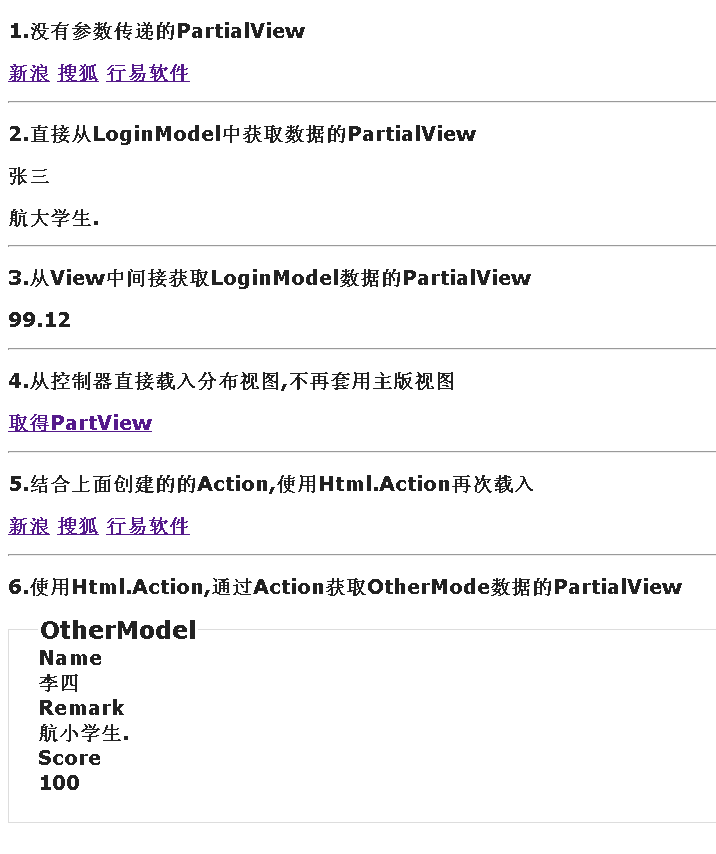A.创建Basic类型的MVC项目.
B.Model目录下,创建文件:
LoginModel.cs:
using System;
using System.Collections.Generic;
using System.Linq;
using System.Web;
namespace MvcPartialViewTest.Models
{
public class LoginModel
{
public string Name
{
get
{
return "张三";
}
}
public string Remark
{
get
{
return "航大学生.";
}
}
public double Score
{
get
{
return 99.12;
}
}
}
}OtherModel.cs:
using System;
using System.Collections.Generic;
using System.Linq;
using System.Web;
namespace MvcPartialViewTest.Models
{
public class OtherModel
{
public string Name
{
get
{
return "李四";
}
}
public string Remark
{
get
{
return "航小学生.";
}
}
public double Score
{
get
{
return 100;
}
}
}
}C.创建HomeController.cs文件:
using System;
using System.Collections.Generic;
using System.Linq;
using System.Web;
using System.Web.Mvc;
using MvcPartialViewTest.Models;
namespace MvcPartialViewTest.Controllers
{
public class HomeController : Controller
{
// GET: /Home/
public ActionResult Index()
{
ViewData.Model = new LoginModel();
return View();
}
public ActionResult GetPartialView()
{
return PartialView("PartialLink");
}
public ActionResult GetPartialView2()
{
return PartialView("PartialDataFromOtherModel", new OtherModel());
}
}
}
C.创建相应的PartialView:
1)PartialLink.cs:
<a href="http://www.sina.com.cn">新浪</a> <a href="http://www.sohu.com">搜狐</a> <a href="http://www.exesoft.cn">行易软件</a>@using MvcPartialViewTest.Models
@model LoginModel
<h2>@Model.Name</h2>
<h2>@Model.Remark</h2>3)PartialDataFromView.cshtml:
@model System.Double
<h2>@Model</h2>
4)PartialDataFromOtherModel.cshtml:
@model MvcPartialViewTest.Models.OtherModel
<fieldset>
<legend>OtherModel</legend>
<div class="display-label">
@Html.DisplayNameFor(model => model.Name)
</div>
<div class="display-field">
@Html.DisplayFor(model => model.Name)
</div>
<div class="display-label">
@Html.DisplayNameFor(model => model.Remark)
</div>
<div class="display-field">
@Html.DisplayFor(model => model.Remark)
</div>
<div class="display-label">
@Html.DisplayNameFor(model => model.Score)
</div>
<div class="display-field">
@Html.DisplayFor(model => model.Score)
</div>
</fieldset>D.创建View文件:
Index.cshtml:
@using MvcPartialViewTest.Models
@model LoginModel
@{
ViewBag.Title = "Index";
}
<h2>1.没有参数传递的PartialView</h2>
<h2>@Html.Partial("PartialLink")</h2>
<hr />
<h2>2.直接从LoginModel中获取数据的PartialView</h2>
@Html.Partial("PartialDataFromLoginModel")
<hr />
<h2>3.从View中间接获取LoginModel数据的PartialView</h2>
@Html.Partial("PartialDataFromView", Model.Score)
<hr />
<h2>4.从控制器直接载入分布视图,不再套用主版视图</h2>
<h2>@Html.ActionLink("取得PartView","GetPartialView")</h2>
<hr />
<h2>5.结合上面创建的的Action,使用Html.Action再次载入</h2>
<h2>@Html.Action("GetPartialView")</h2>
<hr />
<h2>6.使用Html.Action,通过Action获取OtherMode数据的PartialView</h2>
<h2>@Html.Action("GetPartialView2")</h2>























 1421
1421

 被折叠的 条评论
为什么被折叠?
被折叠的 条评论
为什么被折叠?










